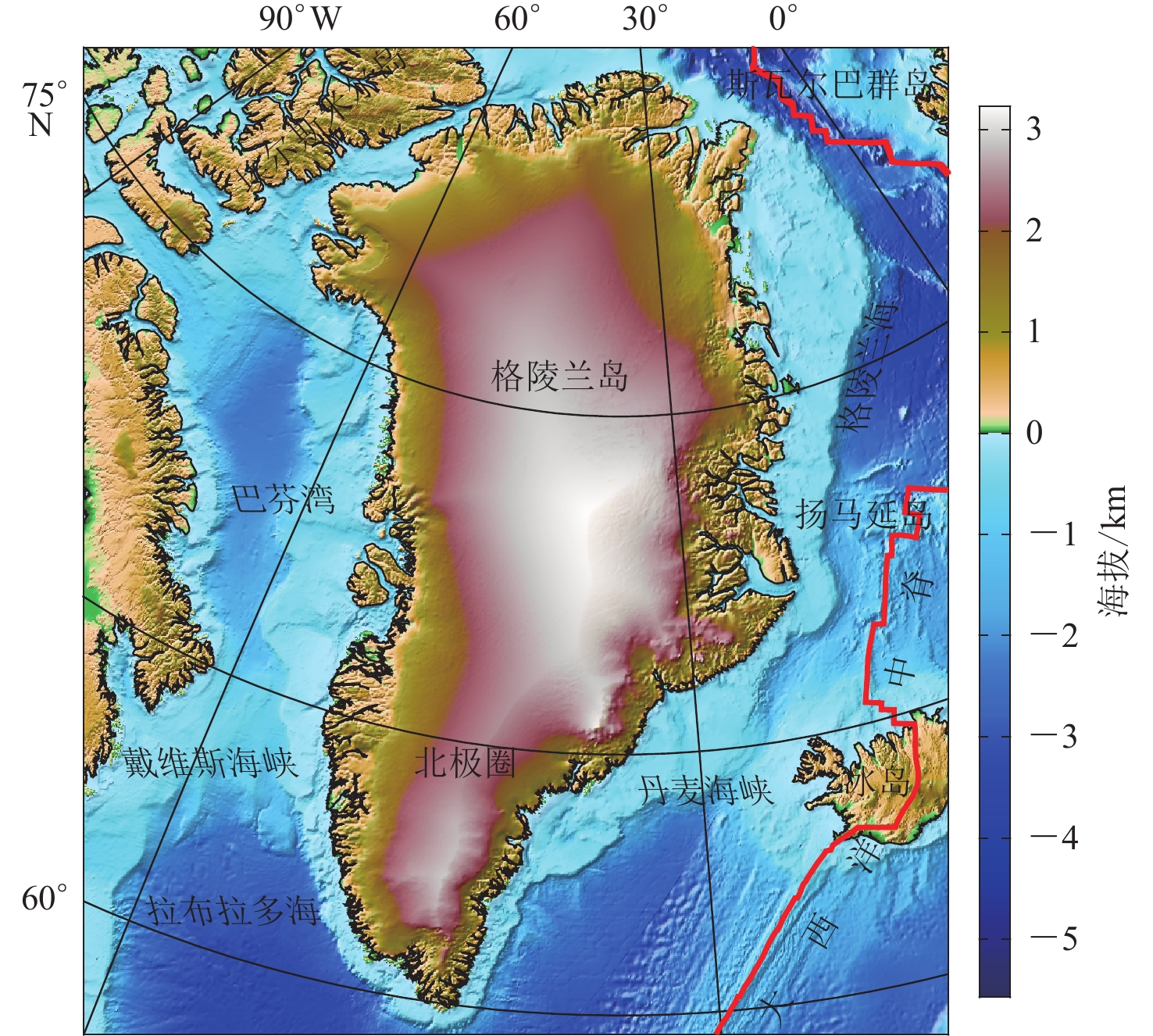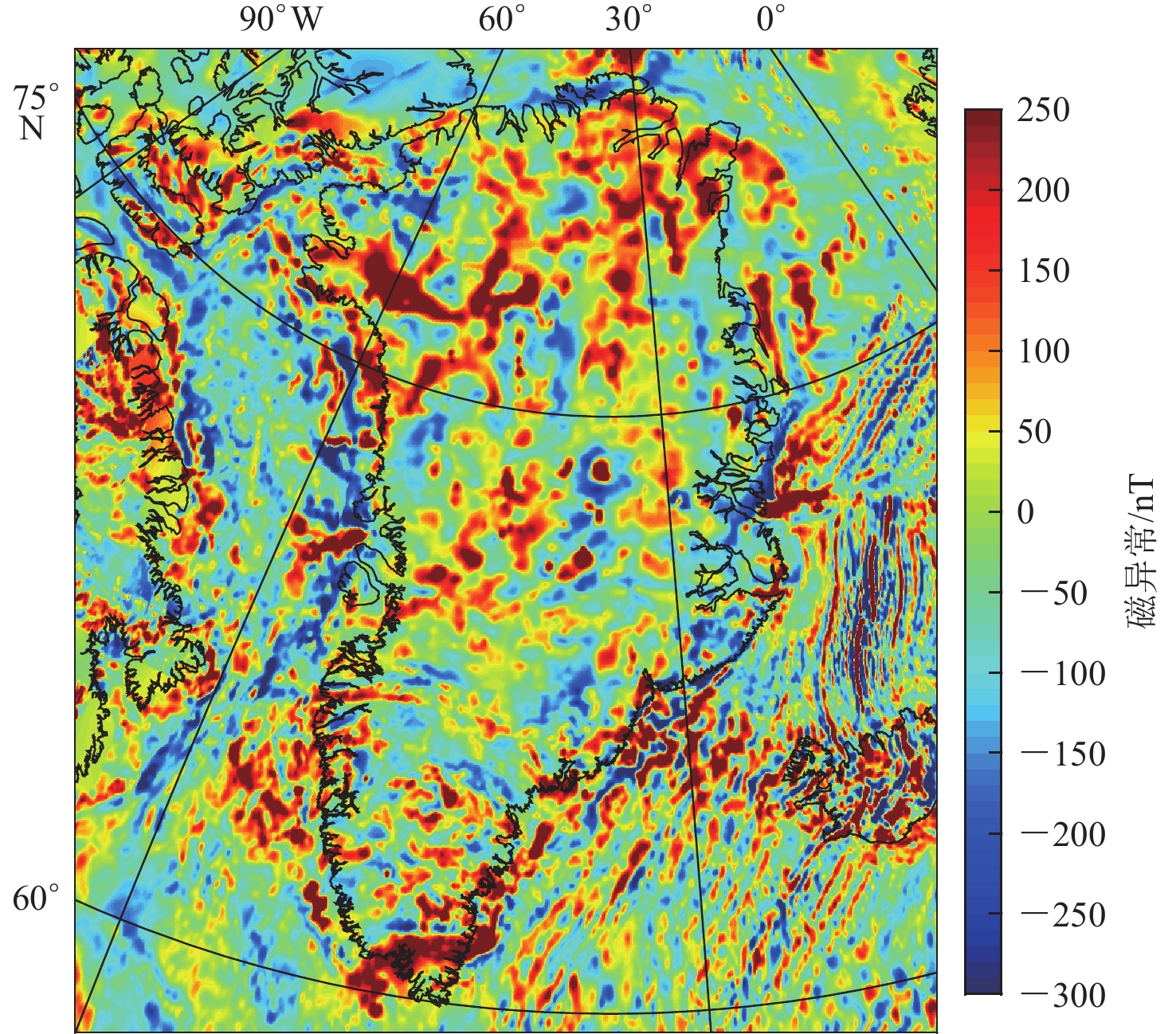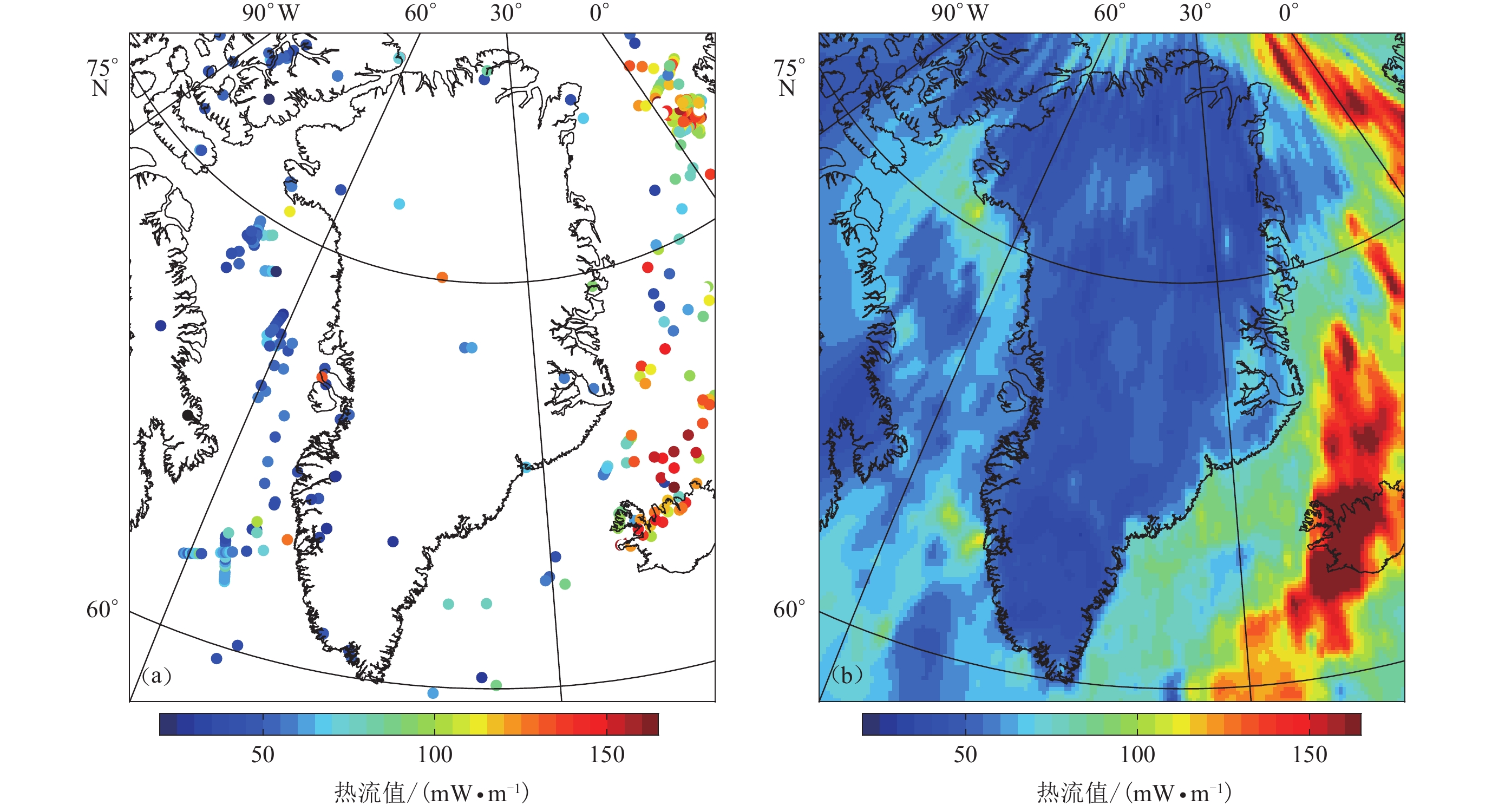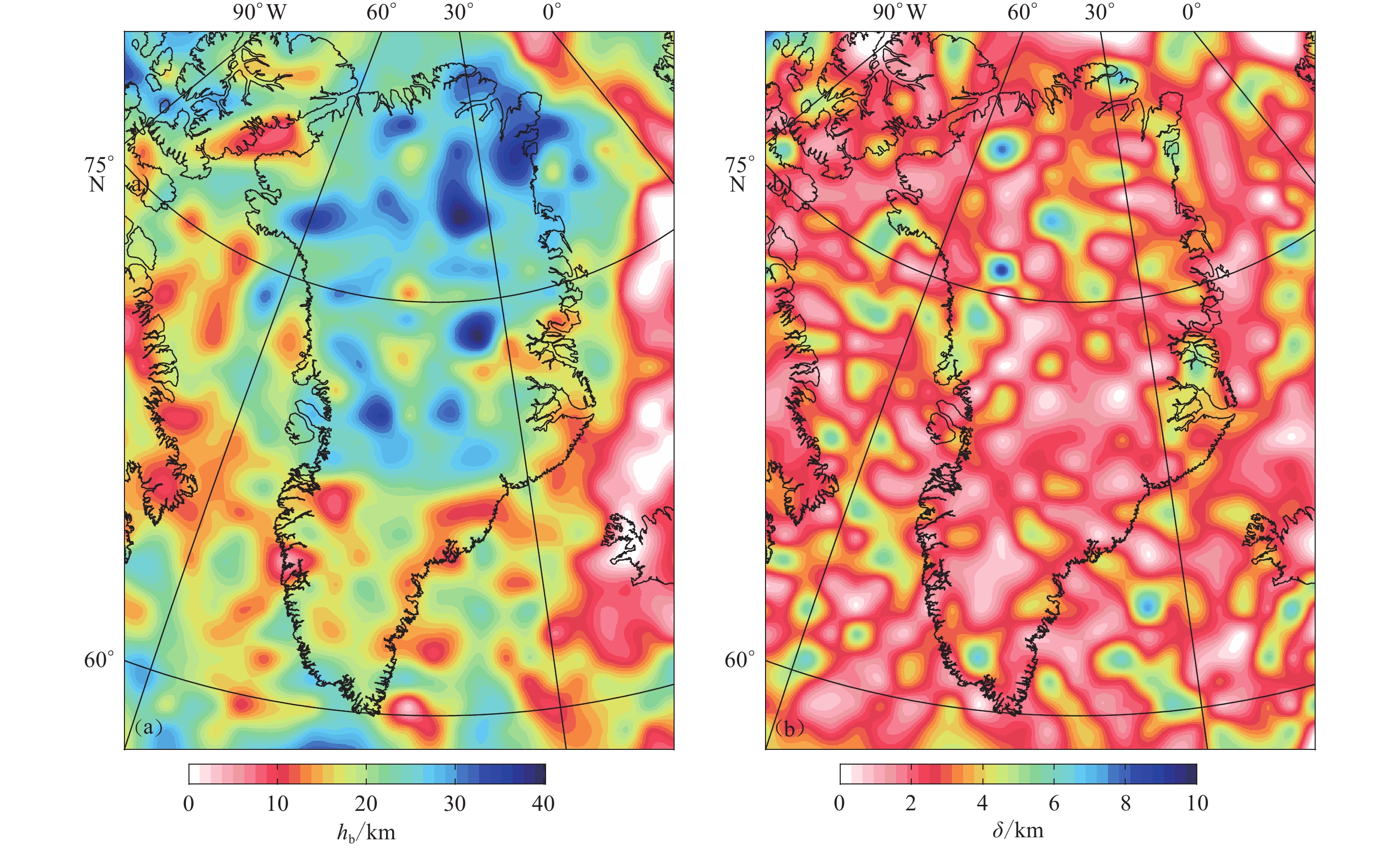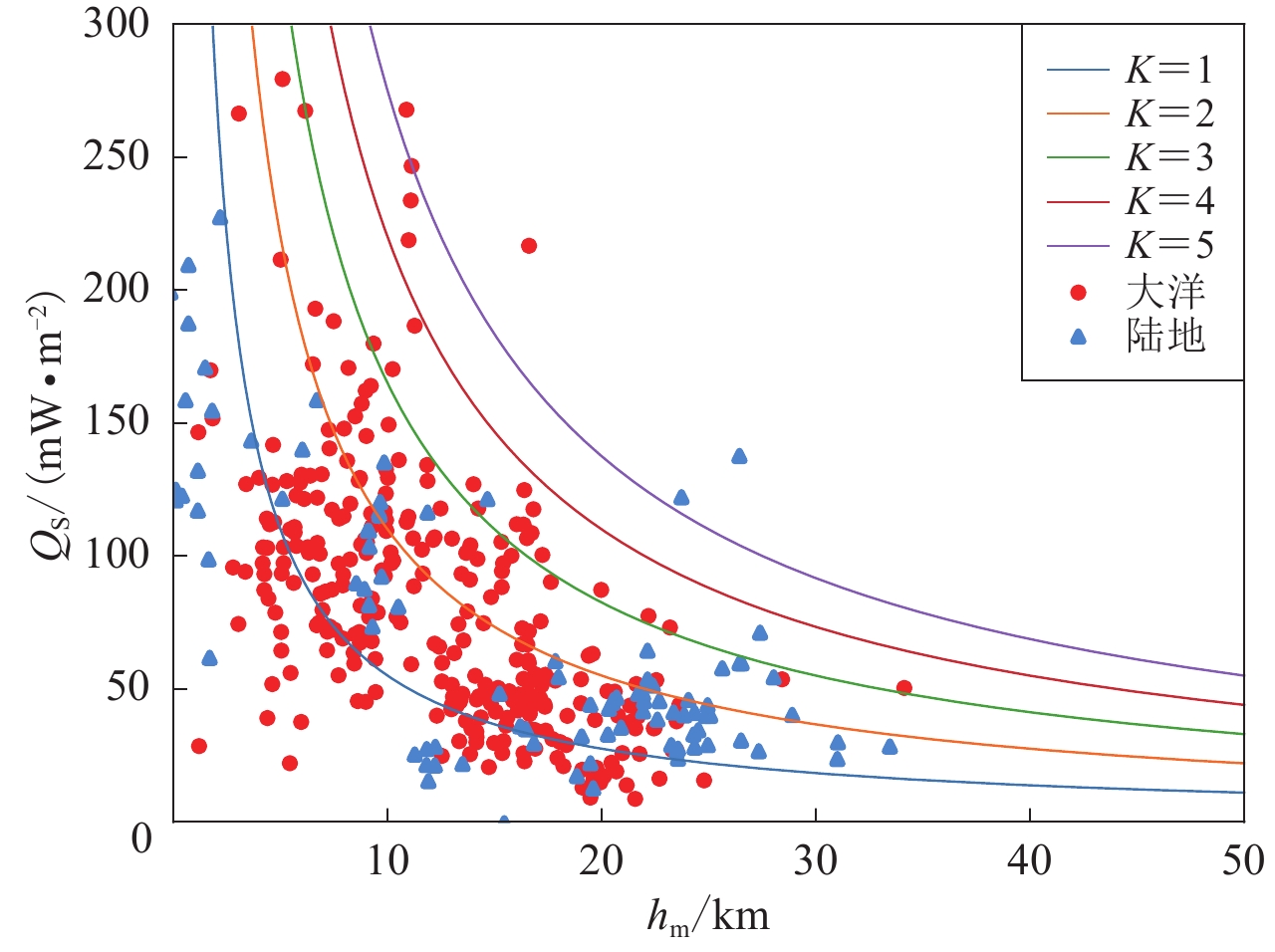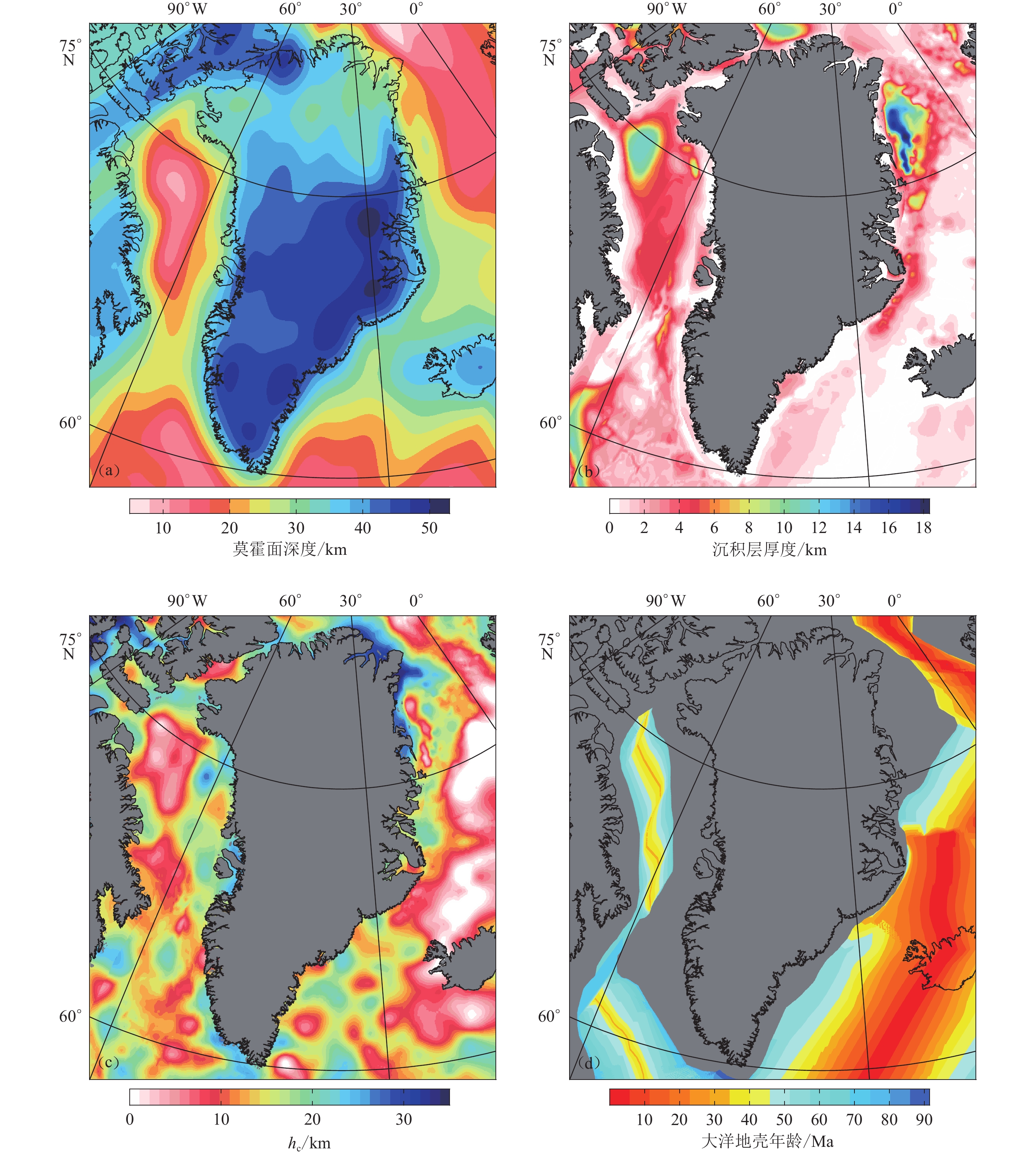Curie depth in Greenland area
-
摘要: 基于全球磁异常数据,利用质心法计算格陵兰岛地区的居里面深度,并结合最新的热流资料、地壳结构和大洋年龄进行分析,加深了对研究区热结构的认识。首先,总结了磁性体满足不同分布时,居里面深度计算的理论公式和校正因子的选择。在格陵兰岛地区应用分形分布,结果表明,研究区居里面深度$ {h}_{{\rm{b}}} $在40 km以内,平均值约为20 km,估算误差约为2.7 km。校正$ {h}_{{\rm{b}}} $得到地形到居里面的距离$ {h}_{{\rm{m}}} $和沉积层底界面到居里面的距离$ {h}_{{\rm{c}}} $,并根据不同的地壳类型对地表实测热流数据校正得到$ {Q}_{{\rm{s}}} $。对比结果显示$ {h}_{{\rm{m}}} $与$ {Q}_{{\rm{s}}} $基本成负相关,计算结果合理。进一步分析表明,研究区居里面总体上浅于莫霍面,但在格陵兰岛北部部分区域居里面深于莫霍面,在大洋地区的$ {h}_{{\rm{c}}} $随洋壳年龄的增大而增大。Abstract: This paper estimates the Curie depth in Greenland area based on the global magnetic anomaly data by using the centroid method. For further analysis we introduce the latest heat flow data, crustal structure and ocean age, which helps to deepen the understanding of thermal structure in the studied area. When the magnetic body satisfies different distribution assumptions, the different theoretical formulas and correction factors for calculating the Curie depth are summarized. Among these distribution assumptions, we apply the fractal distribution assumption to the Greenland area. The result shows that the Curie depth ($ {h}_{{\rm{b}}} $) in the studied area is within 40 km, with an average depth of about 20 km and an estimation error of about 2.7 km. Based on $ {h}_{{\rm{b}}} $, we calculate the distance $ {h}_{{\rm{m}}} $ from topography to Curie depth and the distance $ {h}_{{\rm{c}}} $ from the top crystalline basement to Curie depth. Besides, we correct surface heat flow to obtain $ {Q}_{{\rm{s}}} $ according to different crustal types. We find that $ {Q}_{{\rm{s}}} $ is approximately inversely proportional to $ {h}_{{\rm{m}}} $, which proves that the result is reasonable. Further analysis shows that $ {h}_{{\rm{b}}} $ in the studied area is generally shallower than Moho depth, while in part of the northern Greenland, $ {h}_{{\rm{b}}} $ is deeper than Moho. In the ocean, $ {h}_{{\rm{c}}} $ increases with the age of the ocean crust.
-
Keywords:
- Greenland /
- Curie depth /
- the fractal distribution /
- geothermal heat flow
-
-
图 3 研究区热流实测数据(a)和机器学习预测数据(b)(数据来源于Colgan et al,2022)
Figure 3. Geothermal heat flux in the studied area by measuring (a) and predicting using machine learning method (b)(data from Colgan et al,2022)
图 9 研究区居里面深度与地壳结构和洋壳年龄的对比分析
(a) 莫霍面深度(数据来源于Steffen et al,2017);(b) 沉积层厚度(数据来源于Straume et al,2019);(c) 沉积层底界面到居里面的距离$ {h}_{\mathrm{c}} $;(d) 大洋地壳年龄(数据来源于Seton et al,2020)
Figure 9. Analysis of Curie depth with crustal structure and ocean crustal age in the studied area
(a) Moho depth (data from Steffen et al,2017);(b) Sediment thickness (data from Straume et al,2019);(c) The distance from the top crystalline basement to Curie depth $ {h}_{\mathrm{c}} $; (d) Ocean crustal age (data from Seton et al,2020)
-
江伟伟,李磊,王春晖,杜凌. 2011. 格陵兰岛附近海域海平面变化的初步研究[J]. 中国海洋大学学报,41(10):10–16. Jiang W W,Li L,Wang C H,Du L. 2011. A preliminary analysis on sea level change in the seas near the Greenland[J]. Periodical of Ocean University of China,41(10):10–16 (in Chinese).
Amante C, Eakins B W. 2009. ETOPO1 1 Arc-Minute Global Relief Model: Procedures, Data Sources and Analysis[R]. NOAA Technical Memorandum Nesdis NDGC-24, Boulder: NOAA.
Artemieva I M. 2019. Lithosphere thermal thickness and geothermal heat flux in Greenland from a new thermal isostasy method[J]. Earth-Sci Rev,188:469–481. doi: 10.1016/j.earscirev.2018.10.015
Bamber J L,Siegert M J,Griggs J A,Marshall S J,Spada G. 2013. Paleofluvial mega-canyon beneath the central Greenland ice sheet[J]. Science,341(6149):997–999. doi: 10.1126/science.1239794
Colgan W,Wansing A,Mankoff K,Lösing M,Hopper J,Louden K,Ebbing J,Christiansen F G,Ingeman-Nielsen T,Liljedahl L C,MacGregor J A,Hjartarson Á,Bernstein S,Karlsson N B,Fuchs S,Hartikainen J,Liakka J,Fausto R,Dahl-Jensen D,Bjørk A,Naslund J O,Mørk F,Martos Y,Balling N,Funck T,Kjeldsen K K,Petersen D,Gregersen U,Dam G,Nielsen T,Khan A,Løkkegaard A. 2022. Greenland geothermal heat flow database and map (Version 1)[J]. Earth Syst Sci Data,14(5):2209–2238. doi: 10.5194/essd-14-2209-2022
Kelemework Y,Fedi M,Milano M. 2021. A review of spectral analysis of magnetic data for depth estimation[J]. Geophysics,86(6):J33–J58. doi: 10.1190/geo2020-0268.1
Li C F,Wang J,Lin J,Wang T T. 2013. Thermal evolution of the North Atlantic lithosphere:New constraints from magnetic anomaly inversion with a fractal magnetization model[J]. Geochem Geophys Geosyst,14(12):5078–5105. doi: 10.1002/2013GC004896
Li C F,Zhou D,Wang J. 2019. On application of fractal magnetization in Curie depth estimation from magnetic anomalies[J]. Acta Geophys,67(5):1319–1327. doi: 10.1007/s11600-019-00339-6
Lu Y,Li C F,Wang J,Wan X L. 2022. Arctic geothermal structures inferred from Curie-point depths and their geodynamic implications[J]. Tectonophysics,822:229158. doi: 10.1016/j.tecto.2021.229158
MacGregor J A,Bottke Jr W F,Fahnestock M A,Harbeck J P,Kjær K H,Paden J D,Stillman D E,Studinger M. 2019. A possible second large subglacial impact crater in northwest Greenland[J]. Geophys Res Lett,46(3):1496–1504. doi: 10.1029/2018GL078126
Martos Y M,Jordan T A,Catalán M,Jordan T M,Bamber J L,Vaughan D G. 2018. Geothermal heat flux reveals the iceland hotspot track underneath Greenland[J]. Geophys Res Lett,45(16):8214–8222. doi: 10.1029/2018GL078289
Maus S,Barckhausen U,Berkenbosch H,Bournas N,Brozena J,Childers V,Dostaler F,Fairhead J D,Finn C,von Frese R R B,Gaina C,Golynsky S,Kucks R,Lühr H,Milligan P,Mogren S,Müller R D,Olesen O,Pilkington M,Saltus R,Schreckenberger B,Thébault E,Caratori Tontini F. 2009. EMAG2:A 2–arc min resolution Earth Magnetic Anomaly Grid compiled from satellite,airborne,and marine magnetic measurements[J]. Geochem Geophys Geosyst,10(8):Q08005.
Rogozhina I,Petrunin A G,Vaughan A P M,Steinberger B,Johnson J V,Kaban M K,Calov R,Rickers F,Thomas M,Koulakov I. 2016. Melting at the base of the Greenland ice sheet explained by Iceland hotspot history[J]. Nat Geosci,9(5):366–369. doi: 10.1038/ngeo2689
Ross H E,Blakely R J,Zoback M D. 2006. Testing the use of aeromagnetic data for the determination of Curie depth in California[J]. Geophysics,71(5):L51–L59. doi: 10.1190/1.2335572
Seton M,Müller R D,Zahirovic S,Williams S,Wright N W,Cannon J,Whittaker J M,Matthews K J,McGirr R. 2020. A global data set of present-day oceanic crustal age and seafloor spreading parameters[J]. Geochem Geophys Geosyst,21(10):e2020GC009214.
Steffen R,Strykowski G,Lund B. 2017. High-resolution Moho model for Greenland from EIGEN-6C4 gravity data[J]. Tectonophysics,706/707:206–220. doi: 10.1016/j.tecto.2017.04.014
Straume E O,Gaina C,Medvedev S,Hochmuth K,Gohl K,Whittaker J M,Abdul Fattah R,Doornenbal J C,Hopper J R. 2019. GlobSed:Updated total sediment thickness in the world’s oceans[J]. Geochem Geophys Geosyst,20(4):1756–1772. doi: 10.1029/2018GC008115
Toyokuni G,Matsuno T,Zhao D P. 2020a. P wave tomography beneath Greenland and surrounding regions 1:Crust and upper mantle[J]. J Geophys Res:Solid Earth,125(12):e2020JB019837.
Toyokuni G,Matsuno T,Zhao D P. 2020b. P wave tomography beneath Greenland and surrounding regions 2:Lower mantle[J]. J Geophys Res:Solid Earth,125(12):e2020JB019839.





 下载:
下载:
